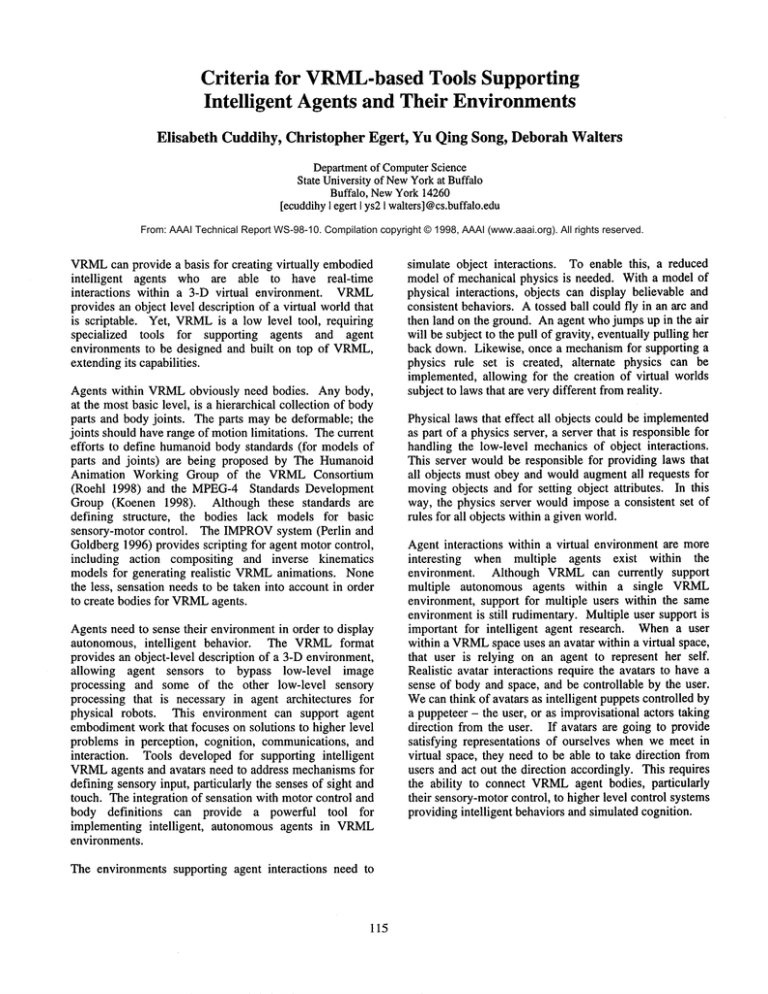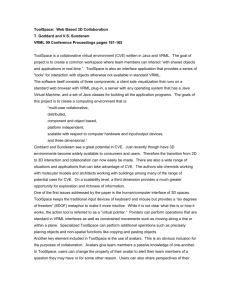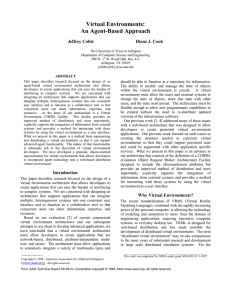
Criteria for VRML-basedTools Supporting
Intelligent Agents and Their Environments
Elisabeth
Cuddihy,
Christopher
Egert,
Yu Qing Song, Deborah Waiters
Departmentof ComputerScience
State Universityof NewYorkat Buffalo
Buffalo, NewYork 14260
[ecuddihyI egert I ys21walters]@cs.buffalo.edu
From: AAAI Technical Report WS-98-10. Compilation copyright © 1998, AAAI (www.aaai.org). All rights reserved.
VRML
can provide a basis for creating virtually embodied
intelligent
agents who are able to have real-time
interactions
within a 3-D virtual environment. VRML
provides an object level description of a virtual world that
is scriptable. Yet, VRML
is a low level tool, requiring
specialized tools for supporting agents and agent
environments to be designed and built on top of VRML,
extendingits capabilities.
Agents within VRMLobviously need bodies. Any body,
at the most basic level, is a hierarchical collection of body
parts and body joints. The parts maybe deformable; the
joints should have range of motion limitations. The current
efforts to define humanoidbody standards (for models of
parts and joints) are being proposed by The Humanoid
Animation Working Group of the VRMLConsortium
(Roehl 1998) and the MPEG-4Standards Development
Group (Koenen 1998). Although these standards are
defining structure, the bodies lack models for basic
sensory-motor control. The IMPROV
system (Perlin and
Goldberg1996) provides scripting for agent motor control,
including action compositing and inverse kinematics
models for generating realistic VRML
animations. None
the less, sensation needs to be taken into account in order
to create bodies for VRML
agents.
Agents need to sense their environmentin order to display
autonomous, intelligent
behavior. The VRMLformat
provides an object-level description of a 3-D environment,
allowing agent sensors to bypass low-level image
processing and some of the other low-level sensory
processing that is necessary in agent architectures for
physical robots. This environment can support agent
embodimentwork that focuses on solutions to higher level
problems in perception, cognition, communications, and
interaction. Tools developed for supporting intelligent
VRML
agents and avatars need to address mechanismsfor
defining sensory input, particularly the senses of sight and
touch. The integration of sensation with motor control and
body definitions
can provide a powerful tool for
implementing intelligent,
autonomous agents in VRML
environments.
The environments supporting agent interactions
need to
115
simulate object interactions. To enable this, a reduced
model of mechanical physics is needed. With a model of
physical interactions, objects can display believable and
consistent behaviors. A tossed ball could fly in an arc and
then land on the ground. Anagent whojumps up in the air
will be subject to the pull of gravity, eventually pulling her
back down. Likewise, once a mechanismfor supporting a
physics rule set is created, alternate physics can be
implemented,allowing for the creation of virtual worlds
subject to laws that are very different fromreality.
Physical laws that effect all objects could be implemented
as part of a physics server, a server that is responsible for
handling the low-level mechanics of object interactions.
This server would be responsible for providing laws that
all objects must obey and would augmentall requests for
movingobjects and for setting object attributes. In this
way, the physics server would impose a consistent set of
rules for all objects within a given world.
Agent interactions within a virtual environment are more
interesting
when multiple agents exist within the
environment. Although VRMLcan currently support
multiple autonomous agents within a single VRML
environment, support for multiple users within the same
environmentis still rudimentary. Multiple user support is
important for intelligent agent research. Whena user
within a VRML
space uses an avatar within a virtual space,
that user is relying on an agent to represent her self.
Realistic avatar interactions require the avatars to have a
sense of body and space, and be controllable by the user.
Wecan think of avatars as intelligent puppets controlled by
a puppeteer - the user, or as improvisational actors taking
direction from the user. If avatars are going to provide
satisfying representations of ourselves when we meet in
virtual space, they need to be able to take direction from
users and act out the direction accordingly. This requires
the ability to connect VRML
agent bodies, particularly
their sensory-motorcontrol, to higher level control systems
providing intelligent behaviors and simulated cognition.
Multiple user support will require several layers of
encapsulation. Not only will each user have their separate
view of the shared environment, but will also need to be
aware of events occurring in the world. This information
will need to be distributed in a timely and efficient manner.
This means that forms of data filtering will have to be
consideredcarefully.
References
Koenen, R. 1998. ISO/IEC JTC1/SC29/WG11Overview
of MPEG-4Version 1,
http://drogo.cselt.stet.it/mpeg/standards/mpeg-4.htm
Perlin, K.; Goldberg, A. 1996. Improv: A system for
scripting interactive actors in virtual worlds. ACM
ComputerGraphics, Annual Conf. Series, pp 205-216.
Roehl, B. 1998. Specification
for a Standard VRML
Humanoid.
http://ece.uwaterloo.ca:80/~h-anim/newspec.html.
Webber, B. 1995. Instructing Animated Agents: Viewing
Language in Behavioral Terms. Proceedings for the
International Conference on Cooperative Multi-modal
116












